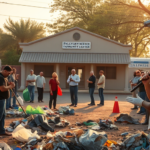**Galeazzi Calls for State Investment in RGV Canals to Address Critical Water Needs**
The agricultural lifeline of the Rio Grande Valley (RGV) may soon see a transformative investment to modernize its irrigation infrastructure—a move that could result in substantial water savings for South Texas. Dante Galeazzi, president and CEO of the Texas International Produce Association, is calling on the State of Texas to allocate $2.5 billion towards lining the Valley’s 3,500 miles of earthen irrigation canals. This investment, he argues, would effectively complement the significant federal funding anticipated from the Infrastructure Bill.
**The Urgency for State Involvement**
In an exclusive discussion, Galeazzi emphasized the critical role of state funding in ensuring the success of this large-scale project, which carries a total estimated cost of $5 billion. “We need the state to match what the federal government can do. Because it’s a huge price tag just to line the 3,500 miles of canals responsible for moving 85 percent of the water in the Rio Grande Valley,” Galeazzi stated.
The call for state involvement is bolstered by strong federal support from key figures, including U.S. Senators John Cornyn and Ted Cruz, alongside U.S. Representatives Monica de la Cruz, Henry Cuellar, Vicente Gonzalez, and Tony Gonzales. According to Galeazzi, these advocates have been instrumental over the past year and a half, yet state-level commitment remains indispensable to realize the full potential of the project.
**The Transformation Potential**
The proposed canal lining project stands to save between 300,000 and 900,000 acre-feet of water annually, a crucial benefit considering that 85% of the RGV’s water supply relies on these outdated canals. Developed largely in the 1940s, these canal systems have remained largely inefficient and leaky.
Updating this infrastructure could yield immediate water savings and support future large-scale projects like saltwater desalination and advanced water treatment systems that aim to secure the Valley’s water future.
**Implications for the Local Community**
For Valley residents, the implications of such an investment are wide-reaching. Local real estate agent Jose Martinez anticipates a brighter future for the region if the canal upgrade proceeds. “This will attract more agricultural investments and create job opportunities. It will definitely uplift the community and bolster economic resilience across the RGV.”
Community members, like long-time Brownsville resident Maria Diaz, share similar sentiments and recognize the importance of securing a stable water supply. Diaz expressed concern for future generations: “It’s crucial that our children have adequate resources to thrive. This project provides the Valley a real opportunity to make that happen.”
**Challenges and Considerations**
While the prospect of enhancing the irrigation infrastructure presents numerous potential benefits, challenges remain. Balancing the financial burden across state and federal entities is no small feat. Additionally, some concerned parties urge consideration of the potential environmental ramifications during the project’s execution.
Dr. Teresa Galvan, an economist at the University of Texas Rio Grande Valley, underscored the importance of strategic implementation. “Investments like these require meticulous planning to avoid unintended consequences that might offset the economic gains.”
**Broader Infrastructure Synergy**
Discussions surrounding this investment underscore the critical balance of federal and state collaboration in infrastructure improvements, which are vital for both environmental sustainability and agricultural productivity. If successful, the RGV initiative could serve as a model for similar regional infrastructure projects nationwide.
Galeazzi remains hopeful yet firm: “This has to be a multi-pronged approach, but most importantly, it has to start today. The longer we delay, the worse this issue gets, and more importantly, the more expensive correcting this issue becomes.”
**Path Forward for Valley Collaboration**
As the proposal progresses, it will be essential for stakeholders to engage in transparent discussions that aim to align interests and address any community concerns. Galeazzi’s plea exemplifies the essence of community interest—prompting Valley leaders, residents, and policymakers to focus on strategic, sustainable water management solutions.
To keep Valley residents informed and engaged, local commissioners plan to host several informational sessions throughout Cameron County and the surrounding areas. These initiatives aim to ensure that community voices influence decision-making—solidifying the RGV’s reputation as a region that collaboratively champions progress for its people.
In summary, the proposed state investment to line the Rio Grande Valley’s canals holds promise to significantly impact local agriculture, economic stability, and water security. Its successful implementation hinges on collaborative efforts among federal, state, and local entities to transform this vision into reality for the greater benefit of all Valley residents.







